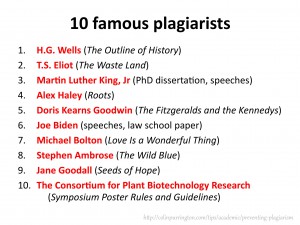Journalism students take entire courses on ethics, and a big portion of it has to do with plagiarism. Still, there are cases every year in which it’s discovered that trained, professional, and reputable reporters are guilty of plagiarizing.
 Content marketers on the other hand, haven’t necessarily been trained in all of the intricacies of plagiarism, and trust us – it goes way beyond just cutting and pasting entire articles. There are quite a few gray areas to be aware of, especially in our world of daily blog deadlines in which everything online seems like it’s fair game to use.
Content marketers on the other hand, haven’t necessarily been trained in all of the intricacies of plagiarism, and trust us – it goes way beyond just cutting and pasting entire articles. There are quite a few gray areas to be aware of, especially in our world of daily blog deadlines in which everything online seems like it’s fair game to use.
What it is Plagiarism
Plagiarism is essentially lifting someone else’s copy or overall message, and not attributing it to them. Everyone hopefully knows that you can’t cut and paste someone’s article, slap your byline on it, and call it a day. But what about if you copy, paste, and rearrange the sentence structure?
- It sounds like it’s not as bad an infraction, but really, it’s not all that different. Changing a few words around is a practice known as “patchwriting,” which is described in detail by Poynter.org. That’s not to say you can’t do some reading and research to help you come up with topic ideas, or to educate yourself about an issue.
- However, if you’re turning someone’s “10 ways to be a better writer” article into “10 tips to make your writing great,” and just reordering and tweaking the tips, that’s plagiarism.
- Also not allowed is what Poynter calls “quote lifting,” in which you incorporate a quote that was published elsewhere into your article, but make it seem like you were given it first hand by not mentioning the original source. (Note: Even though I wasn’t quoting anything in these paragraphs, I made sure you knew that I was attributing these ideas to Poynter since that was my source for this concept, and I drew my ideas directly from it. BOOM.)
Content curation is not Plagiarism
- If you’ve ever rounded up the thoughts of experts or commentary from users on your social media sites into an article, or used tools like Storify, you’ve curated content.
- Content curation is a great way to aggregate what others are saying about a particular issue, and to facilitate a larger conversation.
- It definitely has some value, and as long as the bulk of your content library is your own original content, you can keep on curating worry-free.
- Content licensing: The original sources of these articles are clearly identified, and all parties have agreed to how the content will be used, therefore, this is not plagiarism.
How to avoid plagiarism pitfalls
- When in doubt, attribute. Again, even if you’re paraphrasing what someone else said, you should give that person credit. If you found it online, link back to the article or site.
- As more and more article research takes place online, and more non-journalists enter the content arena, plagiarism – accidental or not – will increase. As you’re writing, take the time to really think about how the audience is perceiving the information you’re giving them, and make sure it reflects the truth.
- If you’re not sure, it’s always better to ask than to get tangled up in accusations of plagiarism.
via blog.visual.ly/plagiarism-what-it-is-what-it-isnt-and-how-to-avoid-it-in-content-marketing/
Related articles
- How CNN Caught Its Alleged Plagiarist – With Google (thewrap.com)
- 5 Reasons Why Plagiarism in Journalism Will Likely Get Worse (plagiarismtoday.com)
- Does anybody still care about plagiarism? (salon.com)